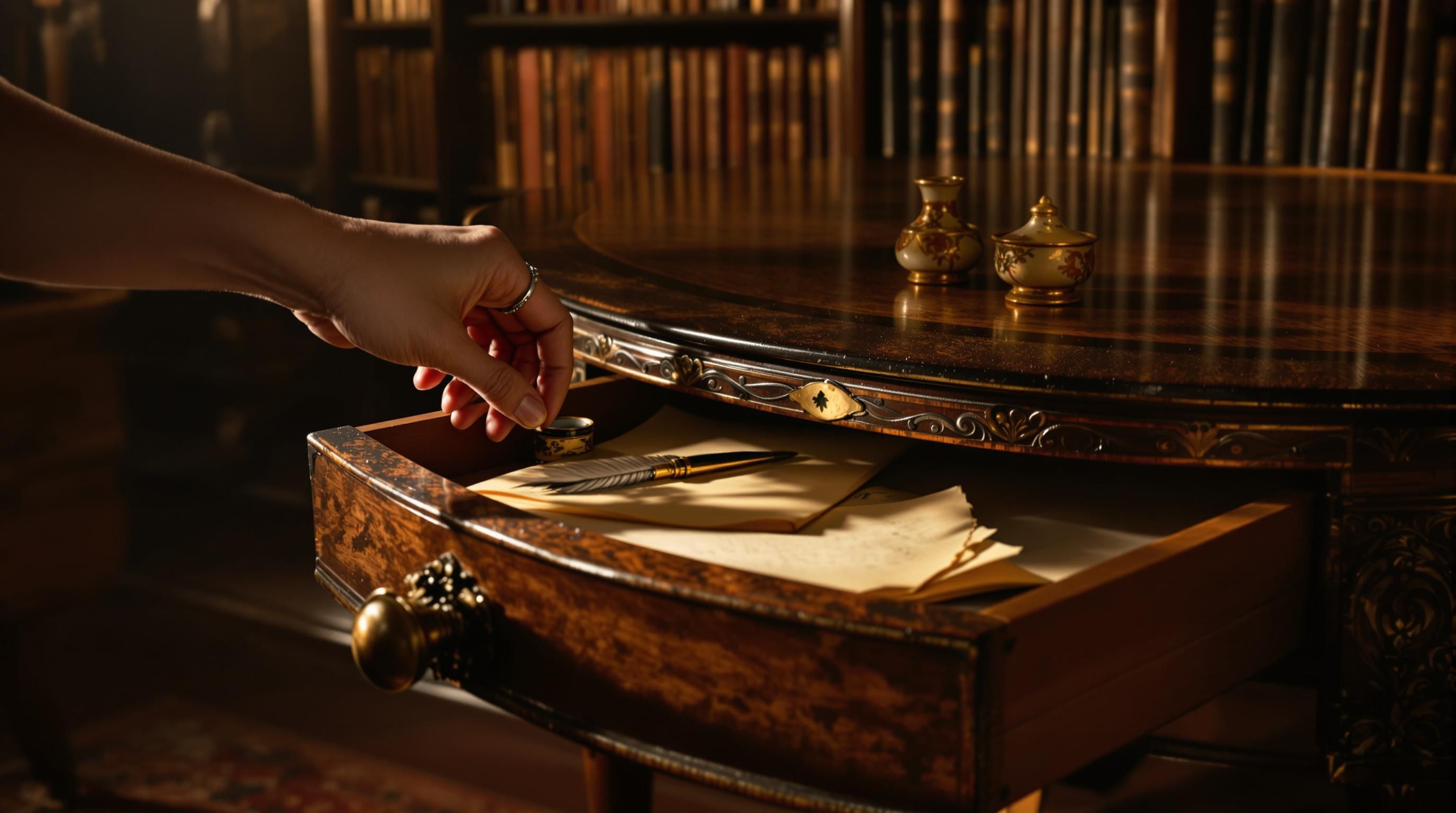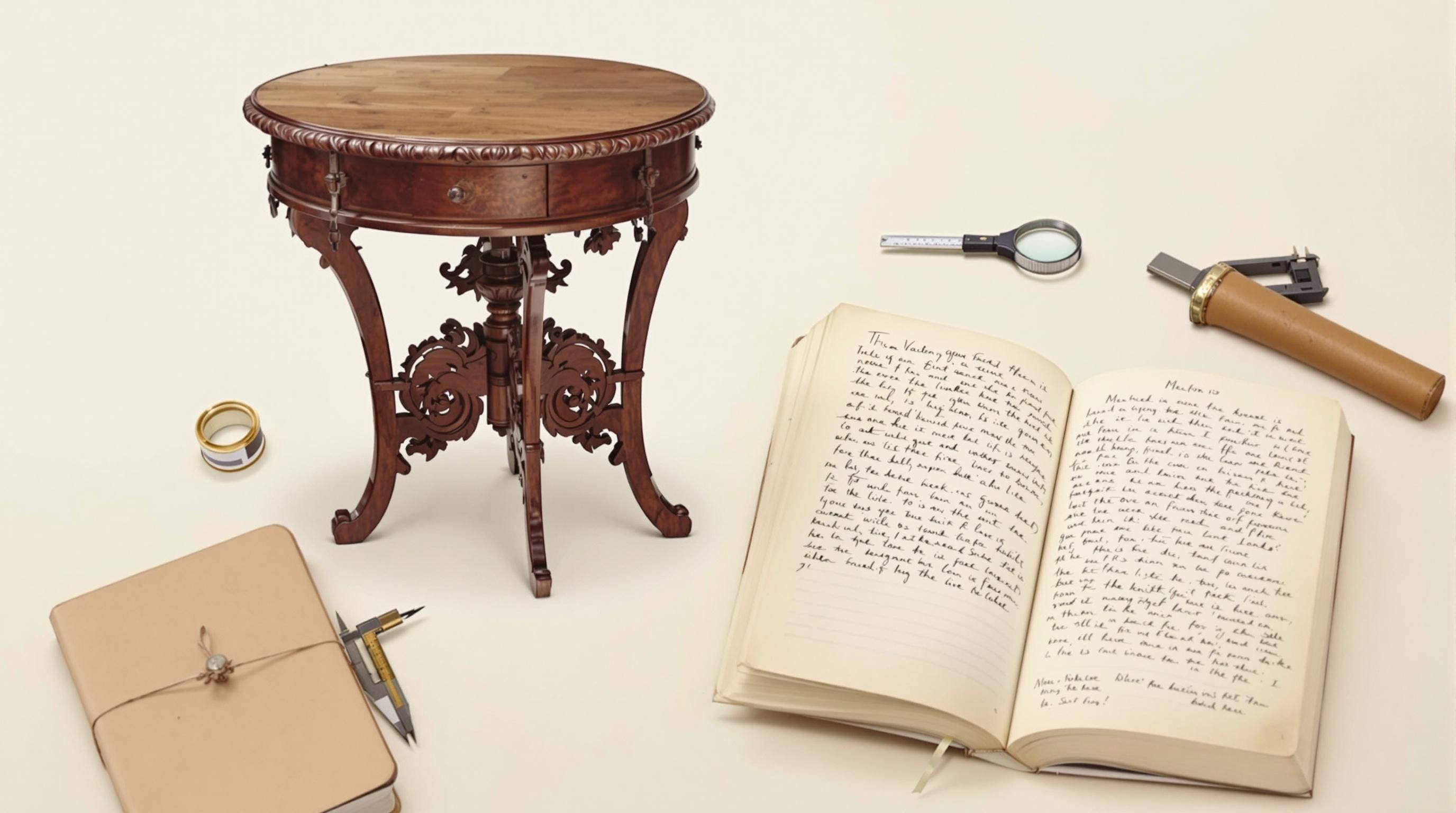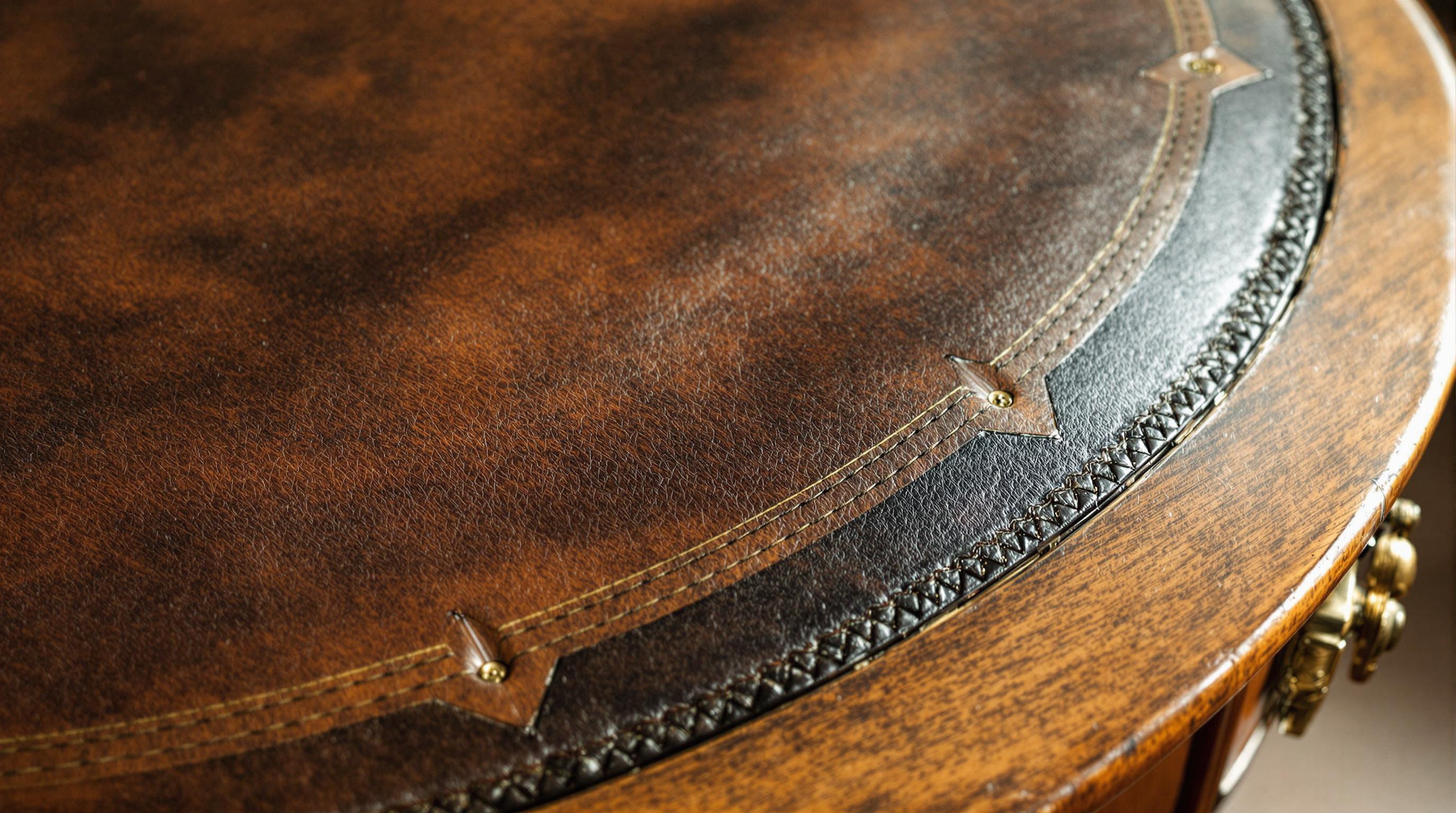Introduction to Antique Drum Tables
Antique drum tables are among the most distinctive and desirable pieces of period furniture collectors seek today. With their circular form, central pedestal, and often elaborately decorated surfaces, these tables have a distinguished history dating back to the late 18th century. Whether you’re considering buying or selling an antique drum table, understanding its value requires knowledge of its history, construction techniques, and current market conditions.
What is a Drum Table?
Drum tables gained popularity in England during the 18th and 19th centuries, particularly during the Regency and Georgian periods. They were traditionally placed in the libraries of affluent homes, serving as practical writing surfaces while providing convenient storage for papers, writing implements, and other personal items.
The distinctive features of a classic drum table include:
- Circular top, often with a tooled leather surface
- Substantial central column support
- Tripod base with decorative feet (often claw and ball)
- Multiple drawers arranged around the perimeter
- Fine woods such as mahogany, walnut, or rosewood
- Decorative brass pulls and other hardware
Today, these elegant pieces continue to be prized by collectors, designers, and antique enthusiasts for both their historical significance and timeless aesthetic appeal.
Historical Timeline of Drum Tables
- Late 18th Century
Origins in Georgian England
Drum tables first appeared in England, featuring simple circular designs with central pedestal supports. - Early 19th Century
Regency Period Refinement
The classic form was refined during the Regency period with more elaborate decoration, leather tops, and brass accents. - Victorian Era
Revival and Adaptation
Victorian craftsmen produced adaptations of earlier styles, often with heavier proportions and more ornate detailing. - Mid-20th Century
Reproduction Period
Quality reproductions of classic designs became popular, with many homes featuring Regency-style drum tables. - Present Day
Collector's Market
Original period drum tables command premium prices, with fine examples appearing regularly at major auction houses.
Factors Affecting Drum Table Values
Age and Authenticity
Genuine period drum tables from the late 18th and early 19th centuries command significantly higher prices than later reproductions. A true Georgian or Regency drum table can be worth several thousand dollars, while a high-quality early 20th-century reproduction might fetch only a fraction of that amount.
According to research from Carters Price Guide, auction results for authentic antique drum tables have ranged from $201 to over $24,400, demonstrating the wide value spectrum based on authenticity and other factors.
Quality of Materials and Construction
The finest drum tables were crafted from superior materials:
- Premium Woods: Solid mahogany was the traditional choice, though walnut, rosewood, and satinwood were also used for high-end pieces.
- Leather Tops: Original tooled leather surfaces in good condition significantly enhance value.
- Hardware: Original brass pulls, locks, and decorative elements are highly desirable.
- Joinery: Superior craftsmanship with precise dovetail joints and careful wood selection.
Condition
The condition has a dramatic impact on value, with original finishes and minimal restoration commanding premium prices.
Drum Table Condition Assessment
Check applicable items to help determine condition quality
- Original finish intact with natural patina
- All drawers function smoothly with original hardware
- Leather top in good condition without excessive wear or damage
- No major repairs, replacements, or structural issues
- Consistent color and wear patterns throughout
- Original feet without excessive wear or replacement
- No water damage, insect damage, or severe wood cracks
- Minimal veneer loss or lifting
Provenance and Documentation
Tables with documented history, especially those from notable collections or historical homes, can command premium prices. Any original receipts, documentation of previous owners, or appearance in published works can significantly boost value.
Style and Decorative Elements
More elaborate examples featuring fine inlay work, marquetry, carved elements, or unusual designs typically achieve higher values than simpler models.
Drum Table Value Factors
Current Market Values for Antique Drum Tables
The market for antique drum tables varies significantly based on all the factors previously mentioned. Here’s a comprehensive breakdown of current market values:
Antique Drum Table Price Ranges
Current market values based on period and condition (2024)
</tbody>
</table>
According to expert appraisers at JustAnswer, a typical resale auction value for quality antique drum tables ranges from $500 to $900, though retail prices in antique stores can reach up to $2,000 for the same pieces.
For the most exceptional examples—such as those with royal provenance, extraordinary craftsmanship, or extremely rare designs—prices can exceed $25,000 at prestigious auction houses.

How to Identify an Authentic Antique Drum Table
Construction Techniques
Authentic period drum tables will show certain construction methods consistent with their era:
- Hand-cut dovetail joints in drawers, often irregular in early examples
- Irregularities in symmetry due to hand craftsmanship
- Tool marks from hand planes and other period tools
- Old growth timber with tighter, more consistent grain patterns
- Secondary woods like oak, pine, or poplar used for drawer interiors
Age Indicators
Look for these signs of genuine age:
- Patina: A natural amber glow that develops over decades or centuries
- Wear patterns: Consistent with long use, especially around drawer pulls and feet
- Old repairs: Evidence of period-appropriate repairs rather than modern techniques
- Oxidation: Darkening of wood in areas exposed to air and light over many years
- Hardware: Hand-forged nails, old screws with irregular threads, and cast brass pulls
Common Reproduction Tells
Be cautious of these warning signs of reproductions:
- Perfectly uniform construction: Too precise to be hand-crafted
- Modern screws with perfect threads
- Artificially distressed finishes that mimic age
- Mixed wood types not typical of the period
- Machine-cut perfect dovetails or other modern joinery
Wood Types and Finishes
The most common woods used in authentic antique drum tables include:
- Mahogany: Rich reddish-brown with straight grain, the most common for quality tables
- Walnut: Darker brown with distinctive grain patterns
- Rosewood: Very dark with dramatic grain, often used for more expensive examples
- Satinwood: Light yellow color, typically used for inlay and banding

Where to Buy and Sell Antique Drum Tables
Buying Antique Drum Tables
For those seeking to purchase an antique drum table, consider these options:
Specialized Antique Dealers: Many high-end dealers offer curated selections of fine furniture, including authenticated drum tables.
Auction Houses: Major auction houses like Christie’s and Sotheby’s regularly feature period furniture in their sales. Prices here typically reflect true market value, though buyer’s premiums add to the cost.
Online Platforms: Sites like 1stDibs and Vinterior offer numerous options from vetted dealers, with current listings showing prices ranging from around $1,600 to several thousand dollars.
Antique Shows and Fairs: These events bring together multiple dealers and can be excellent places to compare examples and negotiate prices.
Estate Sales: Occasionally, fine examples appear in estate sales, sometimes at prices below market value if the seller is unaware of the piece’s significance.
Selling Antique Drum Tables
If you’re looking to sell an antique drum table, these channels offer different advantages:
Consignment with Specialized Dealers: They typically take 30-50% commission but can often secure the highest prices.
Auction Houses: Consider this option for rare or exceptional examples where competitive bidding might drive up the price.
Online Marketplaces: Platforms like eBay and Etsy allow direct sales, though you’ll need to handle shipping logistics.
Direct Marketing: For very valuable examples, seeking out collectors or designers directly might yield the best results.
Local Antique Shows: These can be good venues for mid-range pieces where transportation costs are minimal.
The best option depends on the quality, value, and rarity of your specific table, as well as how quickly you need to sell.
Recent Auction Sales of Antique Drum Tables
Notable auction results for different periods and styles
| Category | Price | Notes |
|---|---|---|
| Genuine Georgian/Regency (1790-1830) | $1,500-$24,000 | Original condition, fine craftsmanship |
| Victorian Period (1837-1901) | $800-$2,500 | Good condition with original features |
| Edwardian Period (1901-1910) | $600-$1,700 | Quality examples with minimal restoration |
| Early 20th Century Reproductions | $350-$900 | Well-made pieces with good patina |
| Mid-Century Reproductions (1950s) | $150-$500 | Regency style with modern construction |
</tbody>
</table>
Restoration and Care
When to Restore
Restoration should be approached cautiously, as inappropriate interventions can significantly reduce value. Consider restoration only when:
- Structural integrity is compromised
- Leather surfaces are severely damaged and detract from usability
- Hardware is missing or non-functional
- Finishes are beyond reasonable preservation
Even then, seek advice from experienced professionals specializing in period furniture before proceeding.
Care and Maintenance Tips
To preserve the value and condition of an antique drum table:
Control environment: Maintain stable humidity levels (35-55%) and avoid direct sunlight.
Regular cleaning: Dust with a soft, clean cloth. Avoid commercial furniture polishes with silicone.
Leather care: Apply a quality leather conditioner specifically formulated for antiques once or twice yearly.
Hardware maintenance: Clean brass hardware gently with appropriate metal cleaners; avoid harsh chemicals.
Protection: Use coasters for drinks, avoid placing hot items directly on the surface, and consider a custom-fit glass top for valuable examples.
Professional inspection: Have valuable pieces examined by a conservator every few years to catch potential issues early.
Documentation: Maintain records of the table’s history, provenance, and any conservation work performed.
Investment Potential of Antique Drum Tables
Market Trends
The market for quality period furniture has shown remarkable stability compared to many other collectibles:
Genuine period pieces from the Georgian and Regency eras have maintained or increased their value over the past decade, especially for exceptional examples.
Middle-market examples (Victorian and Edwardian) have seen more modest but generally stable values.
Reproduction market has weakened somewhat as contemporary taste has shifted, creating potential buying opportunities.
Collecting Strategy
For those considering drum tables as investments:
Focus on quality over quantity: One exceptional example is likely to outperform several mediocre pieces.
Prioritize condition: Original finishes and minimal restoration typically lead to better long-term value retention.
Research provenance: Tables with documented history from important collections or estates tend to appreciate more consistently.
Consider rarity: Unusual forms, woods, or decorative elements can drive higher appreciation.
Buy the best you can afford: As with most investments, the finest examples tend to perform best over time.
Remember that furniture should be enjoyed for its beauty and utility as well as any potential financial return. The best strategy combines appreciation of craftsmanship with careful selection of pieces likely to hold or increase their value.
Common Questions About Antique Drum Tables
How do I find the value of my antique drum table?
To determine the value of your antique drum table:
Research similar examples that have sold recently at auction houses like Christie’s, Sotheby’s, or through online platforms like 1stDibs.
Consider having it professionally appraised by an antique furniture specialist.
Examine key value factors including age, condition, material quality, provenance, and rarity.
Compare your table’s features to the price ranges in our guide above.
Remember that retail values (what you might pay in an antique store) are typically higher than auction or wholesale values (what you might receive when selling).
How old are drum tables?
Drum tables first appeared in England in the late 18th century (around 1780-1790) during the Georgian period. They gained significant popularity during the Regency period (1811-1820) and continued to be produced throughout the 19th century.
The oldest authentic antique drum tables date back approximately 230-240 years. Many fine examples were produced during the early to mid-19th century, while high-quality reproductions have been made continuously since the Victorian era.
What era are drum tables from?
Drum tables originated in the Georgian era of English furniture design (late 18th century) and reached their peak popularity during the Regency period (1811-1820). They continued to be produced throughout the Victorian and Edwardian periods, with various stylistic adaptations.
The style was revived in the mid-20th century, with many quality reproductions created during the 1950s and 1960s. Today, drum tables remain a classic design that continues to be produced by fine furniture makers.
How do I identify an antique drum table?
To identify a genuine antique drum table:
Examine the construction techniques, looking for hand-cut dovetails, old growth timber, and traditional joinery methods.
Check for natural patina and wear patterns consistent with age and use.
Investigate the hardware for hand-forged nails, early screws with irregular threads, and cast brass pulls.
Look at the underside and hidden areas for signs of genuine age.
Consider the proportions and design details, comparing to documented period examples.
For valuable pieces, consider consulting with an antique furniture specialist who can authenticate the period and origin.
What is the value of an antique drum table with leather top?
Antique drum tables with original leather tops typically command higher values than those without. The value ranges vary widely:
Georgian or Regency period tables (1790-1830) with original leather tops in good condition can range from $2,500 to $15,000 or more.
Victorian examples with leather tops typically range from $800 to $3,000 depending on quality and condition.
Early to mid-20th century reproductions with leather tops generally sell for $350 to $900.
The condition of the leather itself is crucial - original tooled leather in good condition adds significant value, while damaged or replaced leather has less impact on price.
Are 1950s drum tables valuable?
1950s drum tables are generally considered vintage rather than antique and typically have more moderate values:
High-quality 1950s mahogany Regency-style drum tables typically sell for $150-$500.
Exceptional examples from noted manufacturers might reach $600-$800.
Tables from this period with documented designer provenance can occasionally command higher prices.
While not as valuable as genuine Georgian or Victorian examples, well-made 1950s drum tables offer an affordable entry point for collectors and remain functional, attractive pieces of furniture with steady demand.
External Resources for Antique Drum Table Research
Carters Price Guide - Antique Drum Tables
Comprehensive price guide featuring auction results for 47 antique drum tables with prices ranging from $201 to $24,400.
1stDibs Drum Table Collection
Curated selection of authentic antique drum tables from vetted dealers worldwide with detailed descriptions and pricing.
Encyclopaedia Britannica: Drum Table Definition
Authoritative reference information on the history and characteristics of drum tables from a respected academic source.
Selling Antiques: Drum Table Collection
UK-based marketplace featuring antique drum tables from 38 trusted dealers with prices ranging from £550 to £15,000.
Vinterior Antique Drum Tables
Curated collection of unique antique drum tables from top sellers across Europe with detailed provenance information.
JustAnswer Antique Furniture Appraisals
Expert appraisal service providing detailed information on antique drum table values from verified appraisers.
Conclusion: The Timeless Appeal of Antique Drum Tables
Antique drum tables represent a perfect blend of practical function and elegant design that has stood the test of time. From their origins in Georgian England to their continued popularity today, these distinctive pieces showcase the craftsmanship and design sensibilities of their respective eras.
For collectors, decorators, and antique enthusiasts, drum tables offer versatile beauty that works in both traditional and eclectic interiors. Their compact form provides useful surface area without overwhelming a space, while their storage capabilities add functional value beyond mere aesthetics.
When evaluating a drum table for purchase or sale, remember that authenticity, condition, and provenance remain the primary determinants of value. By applying the knowledge in this guide, you’ll be better equipped to assess the true worth of these enduring treasures.
Whether you’re a serious collector seeking investment-grade furniture or simply appreciating these tables for their beauty and history, understanding their value helps ensure you make informed decisions in the fascinating world of antique furniture.
Get a Professional Appraisal
Unsure about your item’s value? Our certified experts provide fast, written appraisals you can trust.
- Expert report with photos and comps
- Fast turnaround
- Fixed, upfront pricing
No obligation. Secure upload.
| Item | Price | Date | Auction House |
|---|---|---|---|
| Georgian Mahogany Drum Table, c.1800 | $8,250 | March 2024 | Christie's |
| Regency Style Rosewood Drum Table, c.1900 | $1,750 | January 2024 | Bonhams |
| Edwardian Mahogany Drum Table | $1,634 | February 2024 | 1stDibs |
| Victorian Walnut Drum Table | $875 | December 2023 | Skinner Auctioneers |
| 1950s Mahogany Regency Style Drum Table | $175 | April 2024 | Local Auction |




